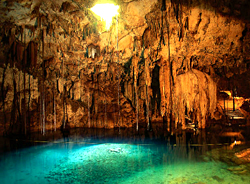DK Science: Rivers
Rivers drain the surrounding land, carrying water that falls as rain and snow down to the sea. As rivers flow, they erode (wear away) rock, breaking it into fragments, called sediments, that are carried downstream. Most erosion occurs when rivers flood after heavy rain or as mountain snows melt in spring. Over time, erosion creates valleys and waterfalls, and sediments form land areas called flood plains and deltas.
A river has three main stages. In the first, the river is steep and narrow and its flow is rapid and rough. In the second stage, it is wider, less steep and flows more smoothly through flat-bottomed valleys. In the third stage, the river is broad and flows placidly across flat coastal plains to the sea, where it drops its sediment.
When water flows over some rocks, such as limestone, caves may be formed by a process called chemical weathering. Water seeps into cracks and gradually dissolves the rock, widening the cracks until, over thousands of years, the limestone becomes riddled with caves and passageways. Water flowing through caves forms underground streams, rivers, and pools (such as this one in Mexico). Surface rivers disappear into sink holes and reappear many kilometres away. Eventually a cave roof may fall in, creating a gorge.

